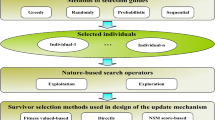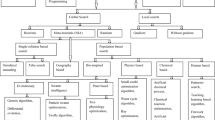Abstract
In a textile mill, ring and rotor spinning processes are the main technologies employed to convert cotton fibres into yarns with desirable qualities. It has been observed that in order to produce yarns having satisfactory quality characteristics, those spinning processes need to be run while setting different input variables (control parameters) at their optimal operating levels. In this paper, the optimal parametric combinations of back and front zone variables in a ring frame, and input variables in a rotor spinning process are determined based on teaching-learning-based optimization algorithm. The optimization performance of this algorithm is also compared with four other techniques, e.g., firefly algorithm, differential evolution algorithm, cuckoo search algorithm and quantum particle swarm optimization algorithm with respect to accuracy and consistency of the derived solutions. This optimization technique can thus be effectively applied to any of the intermediate processes in a textile mill to obtain the best combinations of different input variables so as to achieve the target quality characteristics.






Similar content being viewed by others

References
Admuthe LS, Apte SD (2009) Optimization of spinning process using hybrid approach involving ANN, GA and linear programming. Proc. of the 2nd Bangalore Compute Conference, India, Article No. 20, 1-8
Ahmadjonovich KS, Xaydarovich MU, Abdullajonovich BU, Obidkhon ugli RD (2020) Investigation of optimization of the speed of the working parts of a rotor spinning machine. Int J Future Generation Commu Netw, 13(4): 964-975
Banerjee D, Ghosh A, Das S (2013) Yarn strength modelling using genetic fuzzy expert system. J Inst Eng 93(2): 83–90.
Chakraborty S, Diyaley S (2018) Multi-objective optimization of yarn characteristics using evolutionary algorithms: a comparative study. J Inst Eng 99(2): 129–140.
Chakraborty S, Mitra A (2018) A multivariate quality loss function approach for optimization of spinning processes. J Inst Eng 99(1): 101–109.
Das S, Ghosh A (2015) Cotton fibre-to-yarn engineering: a simulated annealing approach. Fibres Text in Eastern Europe 23(3):51–53
El-Sayed MAM (2009) Optimizing ring spinning variables and a proposed procedure to determine the Egyptian cotton spinning potential. J Text Apparel Technol Manag 6(1):1–9
Feng J, Xu BG, Tao XM (2013) Systematic investigation and optimization of fine cotton yarns produced in a modified ring spinning system using statistical methods. Text Res J 83(3):238–248
Ghane M, Semnania D, Saghafi R, Beigzadeh H (2008) Optimization of top roller diameter of ring machine to enhance yarn evenness by using artificial intelligence. Indian J Fibre Text Res 33(4):365–370
Gulsevincler E, Usal MR, Yilmaz D (2020) Yarn evenness parameters optimization in jetring spinning process. J Text Inst 111(4):540–549
Hasanuzzaman DPK, Basu S (2015) Optimization of ring spinning process parameters using response surface methodology. J Text Inst 106(5):510–522
Ishtiaque SM, Rengasamy RS, Ghosh A (2004) Optimization of ring frame process parameters for better yarn quality and production. Indian J Fibre Text Res 29(2):190–195
Jadhav C, Kamble A (2017) Optimization of spinning process using computational intelligence. Int J Latest Trends Eng Technol 8(1):1–9
Karthik T (2014) Studies on the spinnability of milkweed fibre blends and its influence on ring compact and rotor yarn characteristics. Ph.D. Thesis, Anna University.
Karthik T, Murugan R (2016a) Optimization of drafting zone variables in ring spinning for the production of cotton/milkweed blended yarns. Indian J Fibre Text Res 41(2):121–128
Karthik T, Murugan R (2016b) Optimization of process variables in rotor spinning for the production of cotton/milkweed blended yarns. Indian J Fibre Text Res 41(3):263–269
Kumar A, Ishtiaque SM (2009) Optimisation of a textile process using Taguchi method. The Open Text J 2(1):16–28
Lawrence CA (2003) Fundamentals of Spun Yarn Technology. CRC Publications, USA
Li X, Bu Z, Chang W, Lv P, Liu L (2020) Optimization of dynamic model of ring-spinning yarn balloon based on genetic-algorithm parameter identification. J Text Inst 111(4):484–490
Mansuri AK, Somani SK (2020) Design and optimization of process in spinning mill to improve quality and productivity of yarn. Int J Recent Technol Eng 8(5):1845–1850
Raian S, Siddiqua T, Shanzid MLR, Tumpa TR (2019) Optimization of raw material mixing in rotor spun yarn using analytical hierarchy process. Int J Sci Technol Res 8(11):3156–3160
Rao RV, Kalyankar VD (2012) Parameter optimization of machining processes using a new optimization algorithm. Mater Manuf Processes 27(9):978–985
Rao RV, Kalyankar VD (2013) Parameter optimization of modern machining processes using teaching-learning-based optimization algorithm. Eng Appl Artif Intell 26(1):524–531
Rao RV, Savsani VJ, Vakharia DP (2011) Teaching-learning-based optimization: a novel method for constrained mechanical design optimization problems. Comput Aided Des 43(3):303–315
Funding
No financial support was required for this research work.
Author information
Authors and Affiliations
Corresponding author
Ethics declarations
Conflict of interest
The authors declare that they have no conflict of interest.
Ethical approval
This article does not contain any studies with human participants performed by any of the authors.
Additional information
Publisher's Note
Springer Nature remains neutral with regard to jurisdictional claims in published maps and institutional affiliations.
Rights and permissions
About this article
Cite this article
Diyaley, S., Chakraborty, S. Teaching-learning-based optimization of ring and rotor spinning processes. Soft Comput 25, 10287–10307 (2021). https://doi.org/10.1007/s00500-021-05990-0
Accepted:
Published:
Issue Date:
DOI: https://doi.org/10.1007/s00500-021-05990-0



